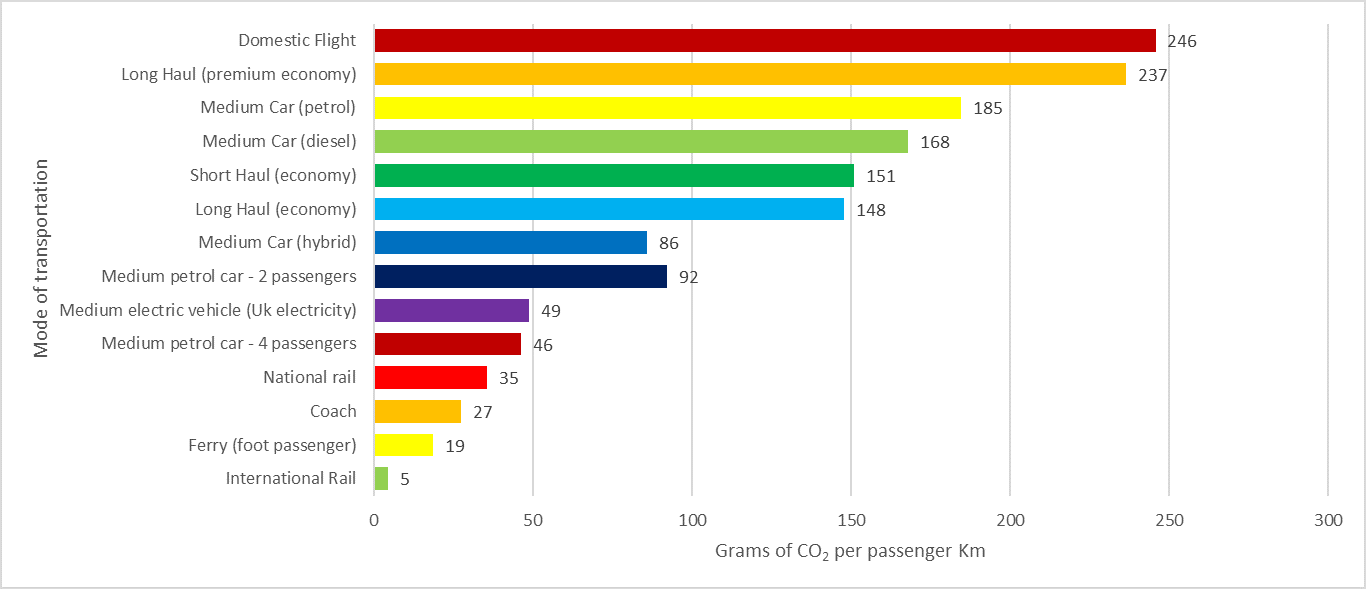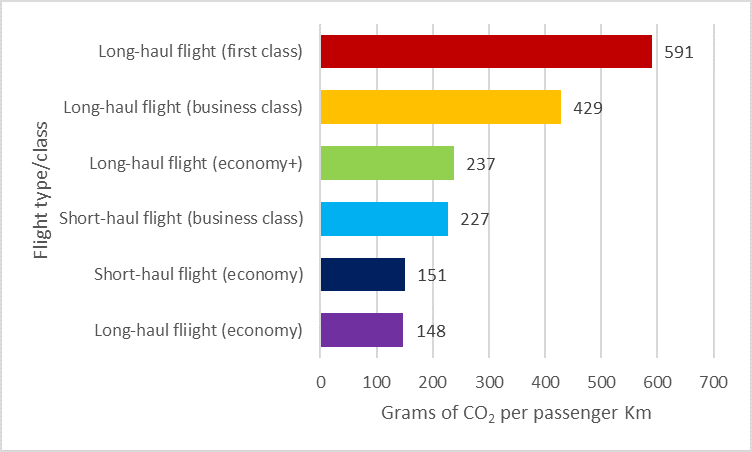How can I make a difference?
Flights make a substantial impact on the University’s carbon footprint. To support our ambitions to reduce carbon associated with business travel, staff should follow the guidance set out in the University’s Travel and Expenses Policy which includes:
Consider if you really need to travel
As a starting point it’s worth considering what you are hoping to gain by travelling in the first place and whether your objectives could be realised in another way – for instance:
- Could you combine efforts so that only one or two people go from a team, rather than everyone?
- Would it impact on your objectives if you were to attend remotely? If so, how?
- What would happen if you didn’t attend?
- What could you do in the time that would be saved by not travelling?
- Is there an alternative online event which would provide some of the same benefits?
- Is there an alternative event which is closer to you which might provide some of the same benefits?
Make alternative arrangements
Thanks to developments in technology there are now more alternative options at our disposal than ever before; so before you plan a trip, we are asking you to consider if you can still meet your aims virtually. For instance, whilst in person meetings still hold a high value for rapport building and networking, once an initial connection has been made those relationships might often be maintained using online options – allowing you to travel less frequently. This might be particularly true if you are already well established in your field and have a network of colleagues and peers in place – whereas an early career researcher may need to travel more initially whilst they build up their network. We understand that the considerations for each person and each trip will vary but we hope that the resources in these pages will enable you to make an informed decision about if, when and how you travel.
Instead of travelling you might choose to:
- Record a video in advance
- Deliver a presentation remotely
- Make a conference call
- Attend via webinar or live stream
- Contact colleagues remotely
Teams and Canvas are available alternatives - if you need any technical support or information, then the IT services team can help.
Optimise your travel plans
Even if some travel is necessary, you can still reduce your emissions as well as save time and money by decreasing the number of trips you take. For example, you might:
- Avoid multiple separate trips to the same area by combining them into a single, longer trip
- Maximise your outputs by increasing the business activities you take in one trip
- Ask conference organisers to provide virtual options or allow increased expenses to cover rail and accommodation costs
- Attend international conferences biennially instead of annually
Case Study: Professor Jo Meehan, Director of the Centre for Sustainable Business in the University of Liverpool Management School
“Academic conferences can be the lifeblood for research communities and provide opportunities to learn, engage, share, debate, support, and collaborate, often in new and inspiring locations. So surely, we would want to go to more of these? In thinking about my own carbon footprint, I have grappled with the value of taking part in international conferences versus the environmental damage of extensive travel that these usually demand. In conversations with other academics, we inevitably find ourselves talking about how busy we all are and the pressures to publish high quality research. The annual conference cycle can force us into artificial timeframes to deliver under-cooked work and as evidence for this I have a growing folder of conference papers that I never got round to writing up into a journal submission or gathering the extra data needed.
I began to rethink my relationship with conferences and how I might embrace ‘slow science’ – giving myself time to sit with my data, reflect on it, be curious about its assumptions and insights, and to provide room for dialogue with those who it may impact. And so, in the spirit of slow science, I have pledged to only attend an international conference, in person, every other year, giving breathing space to develop more careful, high-quality research. Slowing down does not mean I am not collaborating or not being outward facing; in fact, it is the opposite. It encourages me to more consciously reach out to colleagues and collaborators to share learning and engage with different perspectives, and to be careful with our work, making research much more of the international team sport it is supposed to be.”
Make all bookings through the University approved travel provider, Clarity Travel
All flights must book through Clarity Travel so that we can accurately record our business travel carbon emissions. Using Clarity to book your travel supports the University to achieve its ambitious net zero carbon targets allowing us to measure and monitor CO2 emissions related to business travel activities and understand business travel across the University.
The travel portal is accessible via ‘Tools & Services’ on the staff intranet (‘Book travel’). Detailed guidance on how to make a booking, alongside a pre-recorded training session delivered earlier this semester, is available on the Procurement intranet. If you have any questions or feedback regarding the travel portal, please email travelenq@liverpool.ac.uk.
No domestic flights / no flights where travel by Eurostar is possible
The Carbon footprint of travel is measured in grams of carbon dioxide-equivalents per passenger kilometre. This includes the impact of increased warming from aviation emissions at altitude.
Figure 1

As you can see from the graph – domestic flights produce the highest CO2 emissions per passenger kilometre – that’s because the largest concentrated amount of emissions occur at take-off and landing regardless of the duration of the flight so a shorter flight means higher emissions per km travelled.
From January 2025 flights must not be used to travel domestically or to destinations served by Eurostar, unless travelling by train would prevent attending an essential event or meeting due to EDI considerations.
Business travel accounts for approximately 6500 tonnes CO2 per annum, with flights being a significant contributor to our scope 3 emissions footprint. The decision to ban domestic flights will therefore support targeted and active reduction of our scope 3 business travel emissions.
No business class for flights under 9 hours
Business class flights should only be booked for flights lasting nine or more hours in the air, or where there is strong business reason for travelling non-standard class (Premium Economy or Business if Premium Economy does not exist), and prior approval is obtained as set in policy.
As shown in Figure 2, flying economy has the lowest emissions per passenger of all classes, saving up to 443 kg CO2 per passenger km (long haul economy compared with first class); that’s because the seats in first class sections are bigger, meaning less people can be flown around for approximately the same amount of fuel.
Figure 2

Take direct flights
it might seem obvious but changing flights can impact on your carbon footprint - multiple take-off and landing manoeuvres and longer distances increase emissions – so choosing non-stop, direct flights is always preferable.
Fly hand luggage only
Another small change you can make is to fly with hand luggage only – by travelling with hand luggage only you are likely to pack lighter (meaning less fuel is needed by the plane) but you are also avoiding adding to the carbon created by the conveyor belt, luggage car and carousel for checked bags. It might not seem like a lot but given that millions of people travel every day these small changes can add up if we all do our bit.
Take your own reusable supplies
In addition to CO2 emissions, flying can also generate additional waste via single use plastics – that’s why it’s worth being mindful about accepting any complimentary items given out on flights such as eye masks, earplugs, and water bottles and to consider bringing your own items with you, as required, instead.
Did you know?
- A study by UCL found that for every tonne of carbon dioxide one person emits, three square metres of Arctic summer sea ice disappear. This means that by taking a transatlantic flight, one passenger is responsible for the loss of at least six square meters of ice.
- The emissions created by a return flight from Manchester to Beijing are over 9 times the average annual carbon footprint of a person living in Ethiopia (560kg CO2 e)[1]
- 80% of the world’s population have never flown at all2
- 1% of the world’s wealthiest population is responsible for half of all aviation emissions2
- Those who do not fly are also disproportionately affected by the negative effects of climate change2
[1] Source data: UK Government Greenhouse gas reporting: conversion factors 2022
[2] details correct using www.atmosfair.de/en/offset/flight/ as of 05/04/2023